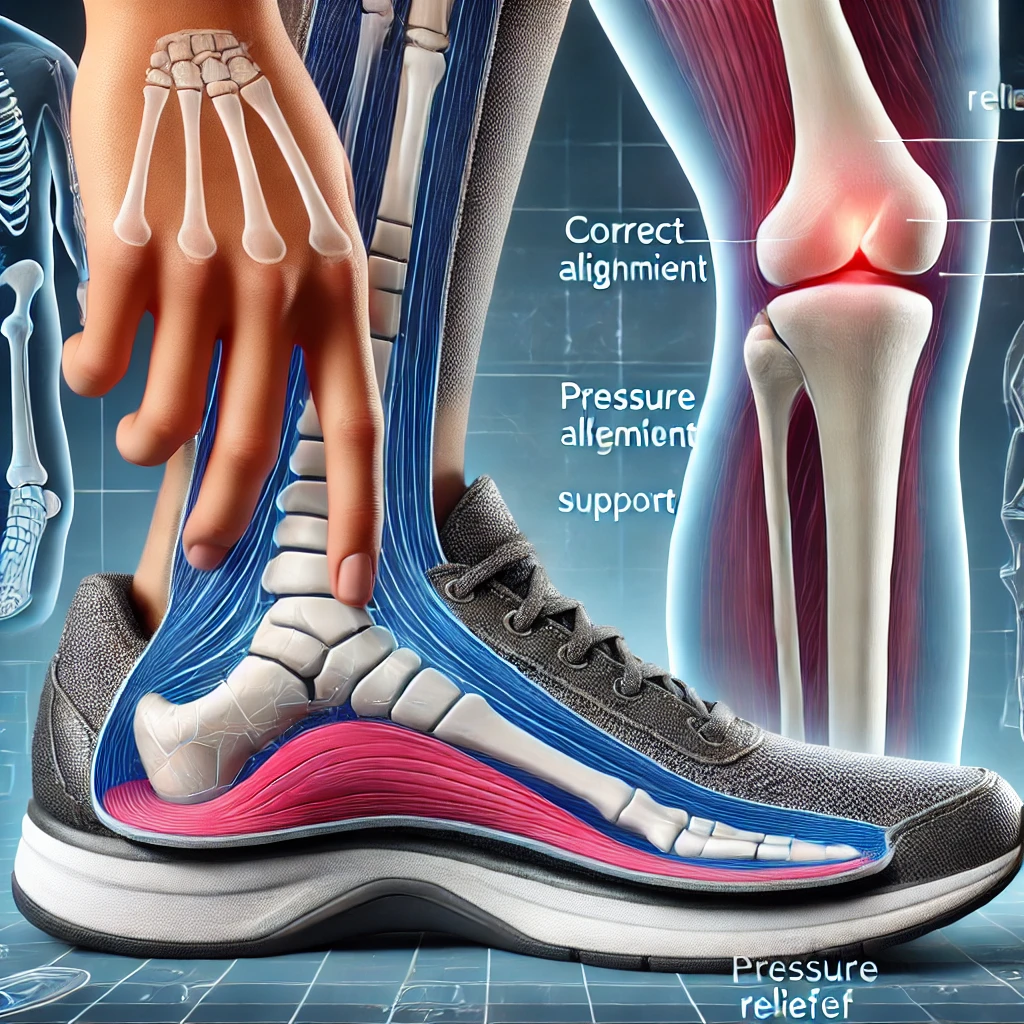|
Getting your Trinity Audio player ready...
|
The Effectiveness of Orthotic Insoles in Musculoskeletal Health

Orthotic insoles, also known as foot orthoses, are devices designed to support, align, or improve the function of the foot. They are commonly used for a variety of musculoskeletal issues, particularly to alleviate foot pain, improve posture, and correct biomechanical abnormalities. Despite their widespread use, the effectiveness of orthotic insoles has been a subject of debate, with varying evidence from clinical trials and systematic reviews.
Types of Orthotic Insoles
Orthotic insoles come in two main forms: custom-made and prefabricated. Custom-made orthoses are specifically tailored to an individual’s foot shape and gait pattern, while prefabricated ones are mass-produced and often less expensive. Both types are used to treat conditions such as plantar fasciitis, flat feet, and overpronation, among others (Mundermann, Nigg, Humble, & Stefanyshyn, 2003).
Evidence Supporting Orthotic Insoles
Several studies suggest that orthotic insoles can provide significant pain relief and functional improvements in certain conditions, particularly in cases of plantar fasciitis. Plantar fasciitis, characterized by heel pain due to inflammation of the plantar fascia, is one of the most common conditions treated with orthotics. According to a randomized controlled trial by Lee et al. (2018), both prefabricated and custom orthotics significantly reduced pain and improved function in patients with plantar fasciitis when compared to placebo interventions.
Another condition where orthotics have shown effectiveness is knee osteoarthritis. Studies have found that lateral wedge insoles, a specific type of orthotic, help reduce the load on the medial compartment of the knee, potentially slowing disease progression (Hinman, Bowles, Payne, & Bennell, 2008). A meta-analysis by Zhang et al. (2018) further supports this, showing moderate reductions in pain and improvement in knee function when using lateral wedge insoles.
Limited or Conflicting Evidence
While orthotics show promise for certain conditions, the evidence for their efficacy in other areas, such as lower back pain and patellofemoral pain syndrome, is less clear. A systematic review by Collins et al. (2008) concluded that while orthotic insoles may reduce the incidence of certain injuries, such as stress fractures in athletes, they do not necessarily improve performance or prevent all lower limb injuries. Furthermore, the review found mixed evidence on their long-term effectiveness in treating patellofemoral pain syndrome.
Similarly, a Cochrane review by Hawke et al. (2008) on the use of orthotics for lower back pain found insufficient evidence to recommend their use. While some patients reported subjective improvements in pain, the authors concluded that more high-quality research is needed to confirm these findings.
Custom vs. Prefabricated Orthotics
There has also been debate about whether custom-made orthotics are more effective than prefabricated ones. Research by Landorf and Keenan (2006) suggests that while custom orthotics may provide a better fit, the clinical outcomes in terms of pain relief and functional improvement are often similar to those of prefabricated devices. This finding is supported by other studies, including a systematic review by Wyndow et al. (2016), which found no significant difference between the two types in treating plantar heel pain.
Conclusion
Overall, orthotic insoles can be effective in managing certain musculoskeletal conditions, particularly plantar fasciitis and knee osteoarthritis. However, their effectiveness may vary depending on the condition being treated and whether the insole is custom-made or prefabricated. The current body of evidence supports their use in specific cases but highlights the need for further research to establish their efficacy in broader applications. As with any medical intervention, it is important for practitioners to base their recommendations on individual patient needs and the best available evidence.
References
- Collins, N., Bisset, L., Crossley, K., & Hinman, R. (2008). Efficacy of foot orthoses in the treatment of lower limb overuse conditions: A systematic review. Journal of Orthopaedic & Sports Physical Therapy, 38(6), 320-332.
- Hawke, F., Burns, J., Radford, J. A., & du Toit, V. (2008). Custom-made foot orthoses for the treatment of foot pain. Cochrane Database of Systematic Reviews, (3), CD006801.
- Hinman, R. S., Bowles, K. A., Payne, C., & Bennell, K. L. (2008). Effectiveness of foot orthoses for the treatment of patellofemoral pain syndrome: A systematic review. British Journal of Sports Medicine, 42(2), 91-96.
- Landorf, K. B., & Keenan, A. M. (2006). Efficacy of foot orthoses: What does the literature tell us? Journal of the American Podiatric Medical Association, 96(1), 24-30.
- Lee, W. C., Wong, W. Y., Kung, E. F., & Leung, A. K. (2018). Efficacy of orthotics in treating plantar fasciitis: A randomized controlled trial. Journal of Orthopaedic Surgery, 26(3), 2309499018797072.
- Mundermann, A., Nigg, B. M., Humble, R. N., & Stefanyshyn, D. J. (2003). Orthotic comfort is related to kinematics, kinetics, and EMG in recreational runners. Medicine and Science in Sports and Exercise, 35(10), 1710-1719.
- Wyndow, N., Collins, N. J., Vicenzino, B. T., & Tucker, K. (2016). Foot orthoses and patellofemoral pain: A systematic review and meta-analysis. British Journal of Sports Medicine, 50(6), 318-328.
- Zhang, W., Liu, J., Jia, Z., & Zhang, Z. (2018). Efficacy of lateral wedge insoles for medial knee osteoarthritis: A meta-analysis of randomized controlled trials. American Journal of Physical Medicine & Rehabilitation, 97(5), 331-340.
